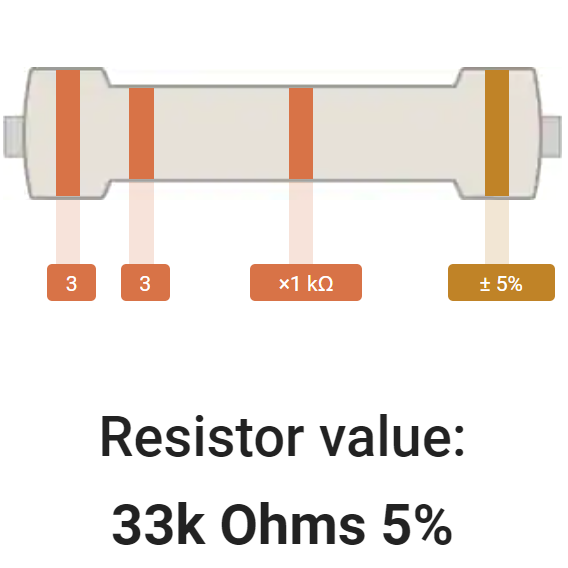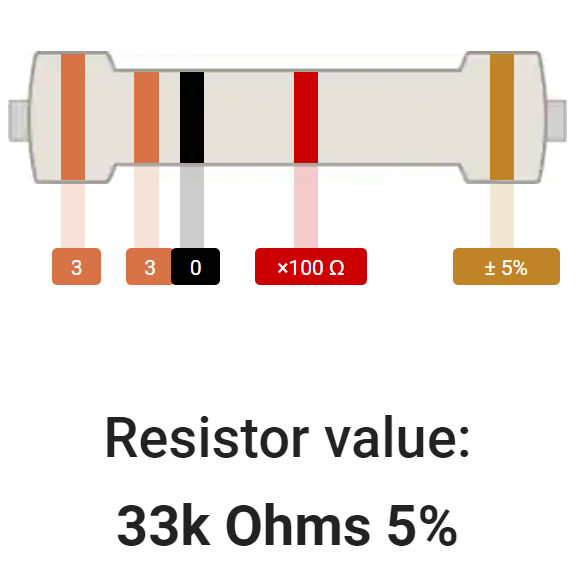What is 33K Resistor?
A 33k resistor, also known as a 33 kilohm resistor, is an electronic component that provides a specific resistance value of 33,000 ohms. It belongs to the family of fixed resistors and is widely used in electronic circuits for various applications. The "k" in 33k represents the metric prefix "kilo," which denotes a multiplication factor of 1,000. This means that a 33k resistor has a resistance 1,000 times greater than a standard 33-ohm resistor.
33K Resistor Color Code 4 Band

4 Band Resistor Color Code | 33k Resistor Color Code| Color | First Band | Secon Band | Multiplier Band | Tolerance Band |
|---|
| Orange | 3 | 3 | 1kΩ | none |
| Orange | 3 | 3 | 1kΩ | none |
| Orange | 3 | 3 | 1kΩ | none |
| Gold | none | none | 0.1 Ω | 5% |
The first band represents the first digit, which is 3, and is represented by the color orange.
The second band represents the second digit, which is 3, and is also represented by the color orange.
The third band represents the multiplier, which is 1,000, and is represented by the color orange.
The fourth band represents the tolerance, which is typically 5%, and is represented by the color gold.
So, the correct color code for a 33k ohm resistor is: orange-orange-orange-gold.
33K Resistor Color Code 5 Band

5 Band Resistor Color Code | 33k Resistor Color Code| Color | First Band | Secon Band | Third Band | Multiplier Band | Tolerance Band |
|---|
| Orange | 3 | 3 | 3 | 1kΩ | none |
| Orange | 3 | 3 | 3 | 1kΩ | none |
| Black | 0 | 0 | 3 | 1Ω | none |
| Red | 2 | 2 | 2 | 100 Ω | 2% |
| Gold | none | none | none | 0.1 Ω | 5% |
The first band represents the first digit, which is 3, and is represented by the color orange.
The second band represents the second digit, which is 3, and is also represented by the color orange.
The third band represents the third digit, which is 0, and is represented by the color black.
The fourth band represents the multiplier, which is 1,00, and is represented by the color Red.
The fifth band represents the tolerance, which is typically 5%, and is represented by the color gold.
Therefore, the correct color code for a 33k ohm resistor using a 5-band color code is orange-orange-black-red-gold.
Resistance tolerance of 33K resistor
The resistance tolerance of a 33k ohm resistor can vary depending on the specific manufacturer and the intended application. However, a common tolerance for resistors in general is 5%, which means that the actual resistance of the resistor can deviate by up to 5% from the stated value.
In the case of a 33k ohm resistor, a 5% tolerance would allow the actual resistance to range between 31.35k ohms (33k ohms - 5%) and 34.65k ohms (33k ohms + 5%).
It's important to note that resistors with tighter tolerances, such as 1% or even 0.1%, are also available for more precise applications where accuracy is critical. These resistors would have a narrower range of acceptable resistance values compared to those with a 5% tolerance.
When selecting a resistor for a specific application, it's important to consider the desired level of precision and the impact that the resistance tolerance may have on the overall circuit performance.
Common Uses for 33K Ohm Resistors
33k ohm resistors have a wide range of applications in electronic circuits. Here are some common uses for 33k ohm resistors:
Voltage Dividers
33k ohm resistors are often used in voltage divider circuits to divide a higher voltage into a lower voltage. By placing a 33k ohm resistor in series with another resistor, the voltage across the 33k resistor can be calculated based on the voltage divider formula. This is useful in applications such as level shifting, biasing circuits, and reference voltage generation.
Current Limiting
33k ohm resistors are also employed as current-limiting resistors. By connecting a 33k ohm resistor in series with an LED or a transistor base, for example, the current flowing through the component can be controlled. This prevents excessive current flow that could damage the component or the circuit.
Timing Circuits
In timing circuits, 33k ohm resistors are often used in conjunction with capacitors to control the timing of events. The time constant of the RC circuit (resistor-capacitor circuit) is determined by the resistance and capacitance values. The 33k ohm resistor helps set the desired time duration for charging or discharging the capacitor.
Pull-Up or Pull-Down Resistors
In digital circuits, 33k ohm resistors are commonly used as pull-up or pull-down resistors to ensure a defined logic level when a switch or a device is not actively driving the signal line. These resistors help prevent the signal line from floating and provide a known state for proper circuit operation.
Biasing Circuits
33k ohm resistors are utilized in biasing circuits to establish the desired operating conditions for transistors or operational amplifiers. They help set the proper bias voltage or bias current required for optimal device performance and stability.
Filter Networks
33k ohm resistors are employed in conjunction with capacitors and inductors to create filter networks that shape the frequency response of a circuit. They are used in low-pass filters, high-pass filters, and band-pass filters to attenuate or pass specific frequency ranges.
Sensor Interfaces
When interfacing with sensors, 33k ohm resistors are often used to provide appropriate biasing or voltage dividers for signal conditioning. They help match impedance levels, attenuate signals, or provide bias voltage for accurate sensor measurements.
These are just a few examples of the common applications of 33k ohm resistors. The versatility of 33k resistors allows them to be used in various circuit configurations to control current flow, set voltages, establish timing, and shape signals to meet the specific requirements of electronic systems.

Nantian Electronics a professional distributor of electronic components, providing a wide range of electronic products, saving you a lot of time, effort and cost through our meticulous order preparation and fast delivery service.
Share this post



FAQ
1.What Colour is a 33K resistor?
The color code for a 33-ohm resistor should be Orange - Orange - Black - [Tolerance].
The first and second bands represent the significant digits, which are orange in this case. The third band represents the multiplier, which is black for a multiplier of 1. The fourth band represents the tolerance, which is Gold indicating a tolerance of +/- 5%.
2.What is the color code for 3.3 K?
The color code for a 3.3 kilohm (K) resistor is Orange - Orange - Red - [Tolerance].
The first and second bands represent the significant digits, which are orange in this case. The third band represents the multiplier, which is red for a multiplier of 100 (10^2). The fourth band represents the tolerance, which is gold indicating a tolerance of +/- 5%.
3.What is the color code for a 30K ohm resistor?
The color code for a 30 kilohm (K) resistor is Orange - Black - Orange - [Tolerance].
The first and third bands represent the significant digits, which are orange in this case. The second band represents the multiplier, which is black for a multiplier of 1 (10^0). The fourth band represents the tolerance, which is gold indicating a tolerance of +/- 5%.
4.What color is a 30K ohm resistor 5 band?
The color code for a 3.3 kilohm (K) resistor is Orange - Black - Black - Red - [Tolerance]